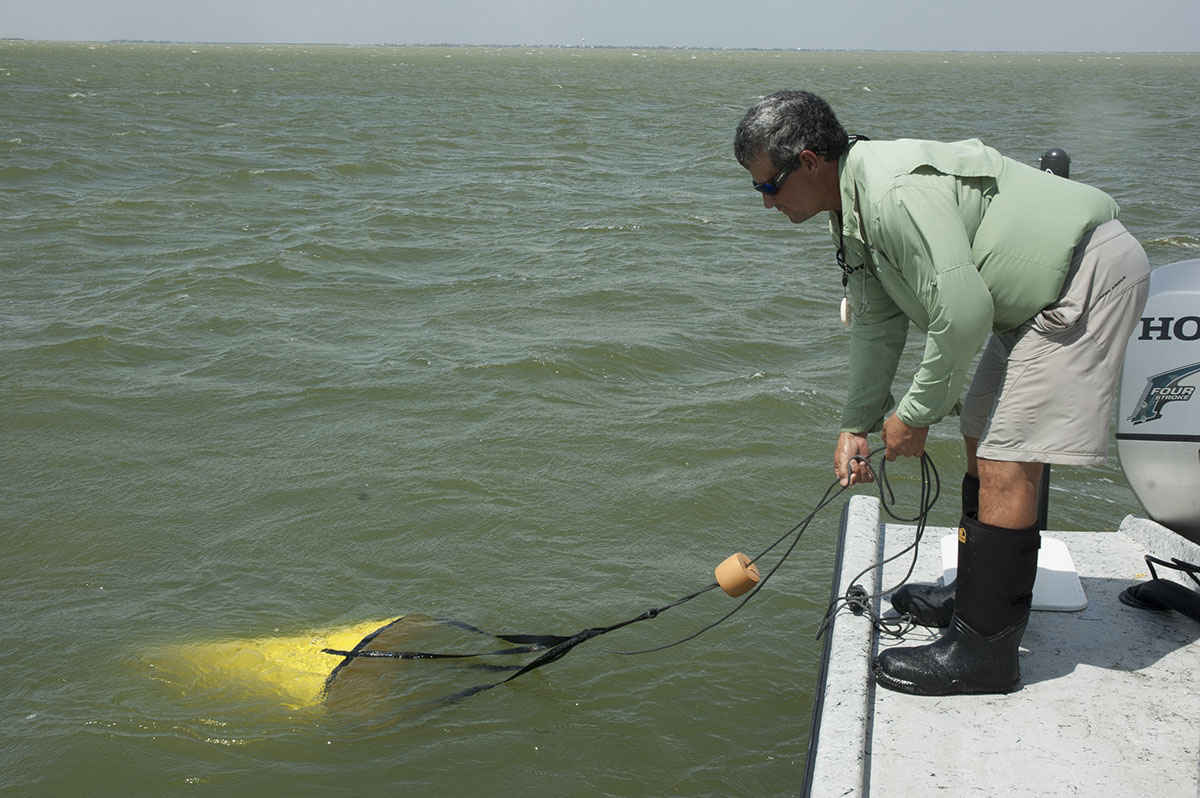A drift sock comes into play on inshore waters as well as offshore.
(An autopilot also makes a nice addition for fishing…just sayin’)
When wind or current push your boat through the strike zone too quickly to effectively present baits, it’s time to take action. Depending on the situation, deploying a sea anchor or using the outboards judiciously solves the problem, yielding a controlled, more effective drift.
LOW DOWN
When kite-fishing with live bait for sailfish, I initially let wind and current dictate the pace of the drift, which is effective when fish are scattered because I cover more territory. However, with a fast current and moderate breeze, when baits race past depth contours, or when we’re in an active zone, I deploy a sea anchor to slow our pace so baits swim longer in more productive zones. Slowing down also allows more precise placement of baits fished at depth, and fragile baits that rarely fare well at a fast clip, stay active. Sea anchors also provide extra time to live-bait or chunk along weed lines and rips for dolphin, over humps and wrecks for blackfin tuna, near canyons and eddies for tuna and swordfish, over schools of kings and Spanish mackerel, or when deep jigging reefs and wrecks. In bays and sounds, a slower drift keeps the boat near sea grasses, rock piles and bars as well as schooling fish, such as seatrout, striped bass, redfish and flounder.
KNOW THE DIFFERENCE
A drift sock, popular for small inshore and midsize coastal boats, is primarily a fishing aid. It is smaller than a true sea anchor, and to function it requires just enough rode to rise and fall in sync with the boat. Its funnel shape creates drag, and depending on how close to the bow or stern the rode is attached, it makes the boat drift broadsided, or keeps the bow or stern into the seas. To retrieve it, you simply pull on the trip line, which brings the narrow end of the drift sock forward, breaking the drag. By contrast, a sea anchor is a safety device first and foremost. It is several times larger than a drift sock, requires much more rode to work properly, and it also creates greater resistance, which slows the drift considerably. Sea anchor-style drift aids are popular aboard big center-consoles, and midsize and large offshore fishing boats that do a lot of live-baiting and chunking.

Tim Barker
Sea anchors aid in multiple offshore strategies
SLOW HAND
In shorter confines, like when fishing over a wreck or dropping to fish marked on the sonar, using the motor(s) to back into and stem the current provides more precision than a drift sock or sea anchor. The amount of throttle and steering adjustments to hold in place depend on current speed and wind influence. More control and precision generally come from reversing into a current. However, if it’s rough, hold the bow into the current instead. Stemming the current enables jigs, live and even cut baits to remain among the fish or over structure long enough to get noticed. One night off Key Largo, Florida, Kevin Jeffries and I lost three large cubera snapper to a wreck we were drifting over. Even with heavy stand-up tackle and 80- and 100-pound braid, it’s nearly impossible to catch these monsters unless they are pulled away from the wreck. The next evening, we marked cuberas schooling 190 feet away from the wreck. We lowered live lobsters as bait, but the current pushed us beyond the school within minutes. We modified our drift by backing into the current. That extra soak time was the ticket, and Jeffries rallied by catching two of the brutes.

George Poveromo
The Skyhook Digital Anchoring System from Mercury Marine combines GPS and the outboards to hold a boat in place. The outboards, governed by GPS, maintain position, shifting and throttling as needed. I’ve used this feature to drop over wrecks, cast along bridges, and investigate a reef to decide if it’s worth dropping anchor. Additionally, it allows everyone on board to fish. The churning from the props in a current may even prompt curious fish — like cobia and amberjack — to rise from a deep wreck. I’ve already used the system near weed lines to tease dolphin to the boat.
RIPS AND COLOR CHANGES
Stemming the current is common practice when live-baiting for sailfish, dolphin, wahoo and kingfish, as well as cobia, striped bass and bluefish. Point the bow of the boat into the seas and deploy baits off the transom. Edge the boat upwind or up-current of the targeted rip or color change until the live baits swim along that edge rather than drifting through before they are noticed. Then apply just enough throttle to maneuver those baits along both sides of the edge to keep them in prime territory.
INSHORE
When searching the down-current side of bridges or working the pilings, ease into casting range by backing into the tide until you’re in position. Fan cast to spots where fish are likely to stage: where they are out of the current but still in postion to ambush bait. Next, throttle forward enough to reach the next set of pilings, slowly drop back to a comfortable casting distance, and then stem the tide. Continue this tactic along the bridge span. On the up-current side, stem the tide with the bow, and keep the anglers fishing from the cockpit. When someone hooks up, throttle forward to keep a hard-charging fish from breaking off on a piling.
Originally posted on https://www.saltwatersportsman.com by: George Poveromo


